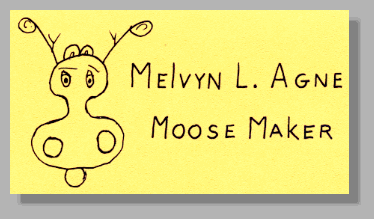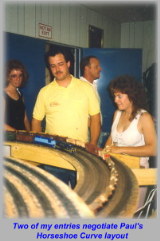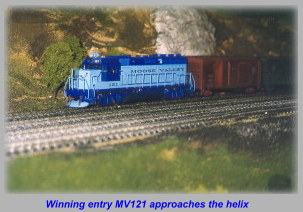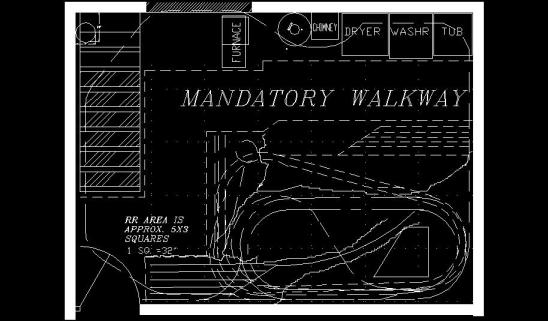

History of the Moose Valley
(The Model)
By Mel Agne
The present day Moose Valley started in 1990 in the basement of an addition we had just
built on to our home. Prior to that, I didn't have a basement, I had an attic.
From the time I was 8 or so, I always had railroads in the attic of our home on
Surrey Drive in Baltimore Maryland. Early ones were Lionel 3 rail O gauge.
These lasted a short while until the conversion to HO on the same platform.
This layout grew into a 12X8X8 L shape with a single track mainline, a figure 8 in
the middle, and an elevated point to point line over most of it. This pike lasted
until the move to Pikesville Maryland following my grandmothers death. The Moose
Valley originally began in 1977, in Pikesville. I conceived it just two years after
the passing of my father. The name "Moose Valley" oddly enough, was not my
creation. My good friend Michael Ward from Richmond Virginia thought it up, based on
his knowledge of my fondness for the word "Moose". I had developed a
cartoon character that was a moose around 1972 and had been drawing him ever since.  It
is this "grown up" Moose that currently adorns the nose of modern day (post 1972
time frame in scale years) locomotives. The Moose Valley paint scheme started right
after the name was invented, and the first unit, an Athearn GP-35 number 101 was done in
Testors blue, number 1108, with the rooftop Testors blue number 1111. Gold
Microscale Railroad Roman Alphabet letters were used to write Moose Valley on its
flank. Since that time, all Moose Valley units have been numbered consecutively
regardless of class or scale. Now that I had a paint scheme, I wanted to
develop a layout in the basement in Pikesville, but it did not come to fruition.
Interestingly, I had started it using a "modular" construction technique that
would later become the forerunner of my present day modular railroading with the Western
Maryland Railway Historical Society. The two modules I had built, were integrated
into a workbench which my father and his brother had constructed in the 40's. The
green power switch from this structure, is now on the console in Berkeley Springs, and
controls the flow of AC power to the layout. Because of high school and other
distractions the Pikesville layout never got far enough to be counted as a pike.
Concurrent with this however, a Penn Central oriented layout had been built in the corner
of our summer cabin in Pennsylvania (where we live now). This layout featured point
to point operation on two levels, and had catenary for a single GG1 which is in the
display case today. In the future, when the Millersburg part of the current railroad
is finished, this PC railroad will be reincarnate - complete with catenary (yes, yes, I
know there never was any catenary in Millersburg, but hey! It's my railroad). This
corner PC pike lasted well into the 80's. In 1987, I married the most beautiful girl
that ever lived next door. We moved to Drumore, PA in Lancaster county and settled
down into a fine 15 by 60 foot trailer. Here, since there was little room for a
railroad of any kind, development of the Moose Valley paint scheme and concept continued.
It
is this "grown up" Moose that currently adorns the nose of modern day (post 1972
time frame in scale years) locomotives. The Moose Valley paint scheme started right
after the name was invented, and the first unit, an Athearn GP-35 number 101 was done in
Testors blue, number 1108, with the rooftop Testors blue number 1111. Gold
Microscale Railroad Roman Alphabet letters were used to write Moose Valley on its
flank. Since that time, all Moose Valley units have been numbered consecutively
regardless of class or scale. Now that I had a paint scheme, I wanted to
develop a layout in the basement in Pikesville, but it did not come to fruition.
Interestingly, I had started it using a "modular" construction technique that
would later become the forerunner of my present day modular railroading with the Western
Maryland Railway Historical Society. The two modules I had built, were integrated
into a workbench which my father and his brother had constructed in the 40's. The
green power switch from this structure, is now on the console in Berkeley Springs, and
controls the flow of AC power to the layout. Because of high school and other
distractions the Pikesville layout never got far enough to be counted as a pike.
Concurrent with this however, a Penn Central oriented layout had been built in the corner
of our summer cabin in Pennsylvania (where we live now). This layout featured point
to point operation on two levels, and had catenary for a single GG1 which is in the
display case today. In the future, when the Millersburg part of the current railroad
is finished, this PC railroad will be reincarnate - complete with catenary (yes, yes, I
know there never was any catenary in Millersburg, but hey! It's my railroad). This
corner PC pike lasted well into the 80's. In 1987, I married the most beautiful girl
that ever lived next door. We moved to Drumore, PA in Lancaster county and settled
down into a fine 15 by 60 foot trailer. Here, since there was little room for a
railroad of any kind, development of the Moose Valley paint scheme and concept continued.  During this time, I entered
several contests at Pauls Model Railroad Shop in New Oxford, Pennsylvania
During this time, I entered
several contests at Pauls Model Railroad Shop in New Oxford, Pennsylvania . On 3 occasions I won
first prize for my locomotives, 2 of which were in Moose Valley paint. It was
through connections there and at the Crossing Hobbies in Lancaster that I eventually ended
up with the famous helix which is in the basement. In order to test and entertain my
locomotives however, I built a pike on a 4' X 3' platform that my father had built and
used for most of my young life to run trains under the Christmas tree. This layout
could run 5 trains, simultaneously! This was accomplished by building it to resemble
a wedding cake. The bottom level had two mainlines with 18" and 15"
radius curves, and the layer above it also used 15" curves, but the loop was set back
to cover the rear two thirds of the bottom level. Above that, 2 N scale loops ran
around - the television, which sat on a lazy susan pedestal. The whole layout was on
short legs which provided room underneath for throttles and the VCR for the TV. The
addition of "Lopper" the lopp eared bunny rabbit which my wife gave me for a 1st
year anniversary present resulted in the installation of Plexiglas around the forward
perimeter of the layout. The genesis for the current track plan was born in
Flintstone, Pennsylvania near Cumberland Maryland. While on a trip to visit my
wife's Aunt and Uncle, I doodled trackplans.
. On 3 occasions I won
first prize for my locomotives, 2 of which were in Moose Valley paint. It was
through connections there and at the Crossing Hobbies in Lancaster that I eventually ended
up with the famous helix which is in the basement. In order to test and entertain my
locomotives however, I built a pike on a 4' X 3' platform that my father had built and
used for most of my young life to run trains under the Christmas tree. This layout
could run 5 trains, simultaneously! This was accomplished by building it to resemble
a wedding cake. The bottom level had two mainlines with 18" and 15"
radius curves, and the layer above it also used 15" curves, but the loop was set back
to cover the rear two thirds of the bottom level. Above that, 2 N scale loops ran
around - the television, which sat on a lazy susan pedestal. The whole layout was on
short legs which provided room underneath for throttles and the VCR for the TV. The
addition of "Lopper" the lopp eared bunny rabbit which my wife gave me for a 1st
year anniversary present resulted in the installation of Plexiglas around the forward
perimeter of the layout. The genesis for the current track plan was born in
Flintstone, Pennsylvania near Cumberland Maryland. While on a trip to visit my
wife's Aunt and Uncle, I doodled trackplans.  The plan shown here was the basis for
everything that came afterwards. Multiple levels were conceived from the start, and
the dogbone mainline was retained. Without the benefit of computer aided drafting,
it wasn't possible to know at that time that this plan would not fit as is. The next
step then, was to translate the idea into a scale drawing which was then followed by
construction. This then was the history of the Moose Valley up to our move back
across the river to York County, to the summer cabin which is now the grand palace -
thanks to two additions, and a new full basement.
The plan shown here was the basis for
everything that came afterwards. Multiple levels were conceived from the start, and
the dogbone mainline was retained. Without the benefit of computer aided drafting,
it wasn't possible to know at that time that this plan would not fit as is. The next
step then, was to translate the idea into a scale drawing which was then followed by
construction. This then was the history of the Moose Valley up to our move back
across the river to York County, to the summer cabin which is now the grand palace -
thanks to two additions, and a new full basement.